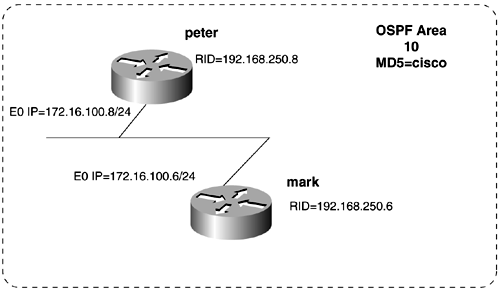Chapter 13. Configuring Bridging and Data Link Switching Plus
| < Free Open Study > |
OSPF AuthenticationOSPF uses two forms of authentication, Type I and Type II. Both forms are fairly easy and straightforward to configure. When configuring passwords, do not enter an encryption type for the password on the interface. Instead, use the global command service password-encryption to enable all password protection after all the configuration is complete. Type 1 AuthenticationType 1 authentication is clear-text authentication. If a sniffer is placed on a network, the password still can be captured, so this is less secure than Type 2. To configure Type 1 authentication, follow this two-step process:
Type 2 AuthenticationType 2 authentication is Message Digest 5 (MD5) cryptographic checksums. OSPF builds a hash value from the OSPF key and password. The hash is the only value sent across the link; no passwords are sent, making MD5 authentication secure. To configure Type 2 (MD5), authentication, follow this two-step process:
Type 1/Type 2 Authentication ExampleFigure 12-12 shows a portion of a network in Area 10. Example 12-29 and Example 12-30 show Type 1 and Type 2 authentication options for OSPF in this network. Figure 12-12. OSPF Authentication Example 12-29 Example 12-29 OSPF Type 1 Authentication on Area 10! hostname peter ! interface Ethernet0 ip address 172.16.100.8 255.255.255.0 ip ospf authentication-key cisco Example 12-30 is the same configuration for Figure 12-11 using MD5 authentication. Example 12-30 OSPF Type 2 Authentication on Area 10! hostname peter ! interface Ethernet0 ip address 172.16.100.8 255.255.255.0 ip ospf message-digest-key 1 md5 cisco |
| < Free Open Study > |
EAN: 2147483647
Pages: 283
- Chapter VI Web Site Quality and Usability in E-Commerce
- Chapter IX Extrinsic Plus Intrinsic Human Factors Influencing the Web Usage
- Chapter XIV Product Catalog and Shopping Cart Effective Design
- Chapter XVI Turning Web Surfers into Loyal Customers: Cognitive Lock-In Through Interface Design and Web Site Usability
- Chapter XVII Internet Markets and E-Loyalty
